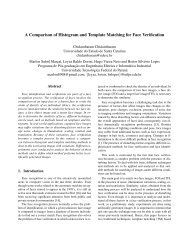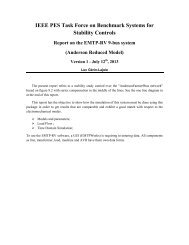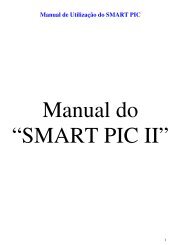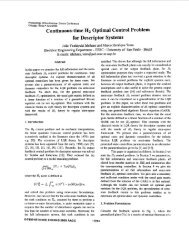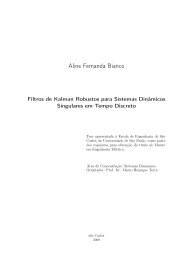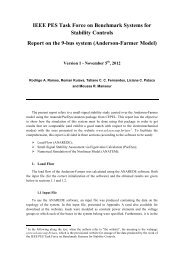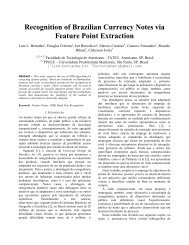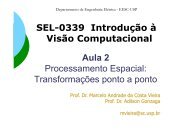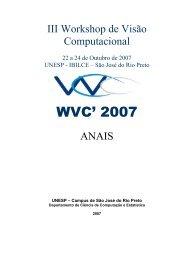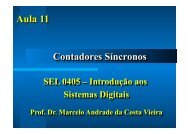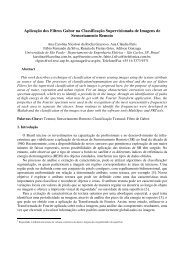computed as follows:{0 if s ∈ S,f max (〈s〉) =+∞ otherwisef max (π ·〈s,t〉) = max{f max (π),d(s,t)}, (8)in which d(s,t) means the distance between samples s andt, and a path π is defined as a sequence of adjacent samples.In such a way, we have that f max (π) computes the maximumdistance between adjacent samples in π, when π is not a trivialpath.The OPF algorithm works with training and testing phases.In the former step, the competition process begins with theprototypes computation. We are interested into finding theelements that fall on the boundary of the classes with differentlabels. For that purpose, we can compute a Minimum SpanningTree (MST) over the original graph and then mark as prototypesthe connected elements with different labels. Figure 3bdisplays the MST with the prototypes at the boundary. Afterthat, we can begin the competition process between prototypesin order to build the optimum-path forest, as displayed inFigure 3c. The classification phase is conducted by takinga sample from the test set (blue triangle in Figure 3d) andconnecting it to all training samples. The distance to alltraining nodes are computed and used to weight the edges.Finally, each training node offers to the test sample a costgiven by a path-cost function (maximum arc-weight along apath - Equation 8), and the training node that has offeredthe minimum path-cost will conquer the test sample. Thisprocedure is shown in Figure 3e.0.30.41.50.40.51.10.00.91.8(a)0.01.11.40.70.70.30.40.41.10.00.9(b)0.00.90.70.7V. DESCRIPTOR COMBINATION USING FIREFLYALGORITHMMansano et. al [14] have proposed an extension to Faria’set al. work [6] by introducing a set of parameters β =(β 1 ,β 2 ,...,β M ) in order to allow a greater variability ofarithmetic computations, which was limited by the linearformulation proposed by Faria et al. [6] (Eq. 9) . Equation10 presents the proposed formulation.δ ∗ D =δ ∗ D =N∑α i δ Di , (9)i=1N∑i=1α i δ βiD i, (10)in which −2 ≤ α i ,β i ≤ 2, β i ∈ R.The optimization algorithms are responsible for computingthe best values for α and β that maximize the accuracy rateover the validation set which is our objective function. As it isknown, each agent (particle, harmony or firefly) represents adifferent solution which changes at the end of each iteration.Each pair (α, β) provides a different training set which isassessed <strong>using</strong> the validation set. The process of computingnew solutions and validation each of them repeats until thenumber of iterations is reached and the best training set of allcomputed is saved in order to run the tests. The purpose ofvalidation the training set is to obtain the set that may providethe highest accuracy rates for a given problem.Thus, the methodology uses three sets: (i) training set whichwill become the final training set, (ii) validation set usedto evaluate the de<strong>sc</strong>riptor combination parameters at eachiteration of the optimization algorithms, and (iii) testing setwhich is used to assess the final training set. Then, the wholeprocess can be split in two phases: (i) the design phase wherethe final training set is modeled by means of optimizationalgorithms which compute the best parameters for the set ofde<strong>sc</strong>riptors, and (ii) classification phase in which each sampleis classified <strong>using</strong> the training model computed in the previo<strong>usp</strong>hase. Figure 4 shows the methodology proposed by Mansanoet. al [14].0.40.40.70.50.6(c)0.0(d)0.40.70.00.40.6(e)Fig. 3. OPF pipeline: (a) complete graph, (b) MST and prototypes bounded,(c) optimum-path forest generated at the final of training step, (d) classificationprocess and (e) the triangle sample is associated to the white circle class. Thevalues above the nodes are their costs after training, and the values above theedges stand for the distance between their corresponding nodes.Fig. 4. Proposed methodology for de<strong>sc</strong>riptor combination. Extracted fromMansano et. al [14]
VI. EXPERIMENTAL RESULTSExperiments used two well-known public datasets:• Corel 1 : It contains 3,906 images labeled in 85 classes,and the number of images per class ranges from 7 to 98images.• Free Photo 2 : A subset of this dataset was employedcontaining 3,426 images labeled in 9 classes, and thenumber of images per class ranges from 70 to 854 images.Different types of de<strong>sc</strong>riptors were computed for eachdataset [15]:• Color Autocorrelogram (ACC): de<strong>sc</strong>riptor of color representingthe space color in 64 bins and 4 values ofdistance.• Border/Interior pixel Classification (BIC): it is a de<strong>sc</strong>riptorof color in which color space is represented by 64bins.• Color Coherent Vector (CCV): de<strong>sc</strong>riptor of color composedby a combination of two histograms of 64 binstotal.• Global Color Histogram (GCH): de<strong>sc</strong>riptor of color inwhich the color space was split in 64 bins.• Homogeneous Texture <strong>De<strong>sc</strong>riptor</strong> (HTD): de<strong>sc</strong>riptor oftexture• Local Activity Spectrum (LAS): de<strong>sc</strong>riptor of texture inwhich components are quantized in 4 bins resulting in ahistogram of 256 bins.• Quantized Compound Change Histogram (QCCH): de<strong>sc</strong>riptorof texture composed by 40 bins.There were computed the ACC, BIC, GCH, LAS and QCCHde<strong>sc</strong>riptors for Corel dataset; and BIC, CCV, LAS, GCH andHTD for Free Photo dataset [16]The set of de<strong>sc</strong>riptors is split in: training, validation andtesting sets. Experiments <strong>using</strong> a single de<strong>sc</strong>riptor used justthe training and testing sets, and experiments involving combinationis performed <strong>using</strong> the 3 sets where the validation setis employed to evaluate the solution given by the optimizationalgorithms. The accuracy rate is computed according to Eq.11.∑ ni=1Acc =ta i, (11)nin which ta i stands for the accuracy rate of class i and nrepresents the number of classes.Table I shows the average accuracy rate of 5 rounds of testsfor each de<strong>sc</strong>riptor and each database <strong>using</strong> the OPF classifier<strong>using</strong> a single de<strong>sc</strong>riptor.Single de<strong>sc</strong>riptor experiments used a training set of 30%of the entire dataset and 50% of the dataset for testing whichwere randomly generated in each round of test. The purpose ofthis first experiment is to compare the gain when de<strong>sc</strong>riptorcombination with optimization algorithms is performed. Resultsshow different performances for each de<strong>sc</strong>riptor in each1 http://vision.stanford.edu2 http://www.freefoto.com<strong>De<strong>sc</strong>riptor</strong>/Dataset Corel Free PhotoACC(HTD) 74.27%±1.13 73.11%±1.31LAS 59.75%±0.60 74.58%±0.65BIC 72.67%±0.20 89.71%±0.96GCH 65.82%±0.76 78.69%±1.25QCCH(CCV) 57.38%±0.60 80.50%±0.61TABLE ISINGLE DESCRIPTOR EFFICIENCY.database where most of them had a better performance in theFree Photo database.Experiments combining different de<strong>sc</strong>riptors included optimizationalgorithms which were employed separately in orderto assess each algorithm’s performance. In this phase, thevalidation set is included in order to evaluate and improvethe training set prior the test step. The parameters of eachalgorithm were set as shown in Table II where there were used250 agents (fireflies, particles and harmonies), 100 iterationsand parameters with similar functions were set with the samevalue (e.g. HMCR from HS and w from PSO) in order tomake a fair comparison.Technique ParametersFFA α = 0.2, β = 1.0, γ = 1.0HS HMCR: 0.7, PAR: 0.7PSO w = 0.7, c 1 = 1.6, c 2 = 0.4TABLE IIPARAMETERS USED IN THE EXPERIMENTS.Since the purpose is to improve accuracy rate in imageclassification, the OPF classifier was employed to assess eachcombination computed by each technique and accuracy ratesfor combinations of 2 and 5 de<strong>sc</strong>riptors, in order words, theaccuracy rate is the objective function to be maximized. TableIII presents the mean accuracy rates for combination of 2(LAS and GCH, empirically chosen) and 5 de<strong>sc</strong>riptors for eachtechnique and dataset.<strong>De<strong>sc</strong>riptor</strong>/Dataset Corel Free PhotoFFA-LAS+GCH 65.82%±0.86 84.48%±0.83HS-LAS+GCH 67.94%±0.74 84.28%±0.43PSO-LAS+GCH 68.04%±0.62 84.52%±0.71FFA-ALL 76.02%±1.05 90.69%±1.06HS-ALL 75.34%±0.81 89.88%±0.91PSO-ALL 76.77%±0.60 90.36%±0.72TABLE IIICOMPOSITE DESCRIPTOR EFFICIENCY ACCORDING TO THE PROPOSEDAPPROACH.Comparing the combination of 2 and 5 de<strong>sc</strong>riptors, it isvisible an improvement of over 8% in Corel database andalmost 6% in the Free Photo, considering the best accuracyrates in each <strong>sc</strong>enario. Among the optimization algorithms,PSO has achieved the best accuracy rates in 3 out of 4situations, although all techniques had similar results.However, comparing performances of single de<strong>sc</strong>riptor andde<strong>sc</strong>riptor combination <strong>using</strong> 5 de<strong>sc</strong>riptors has shown a slight




